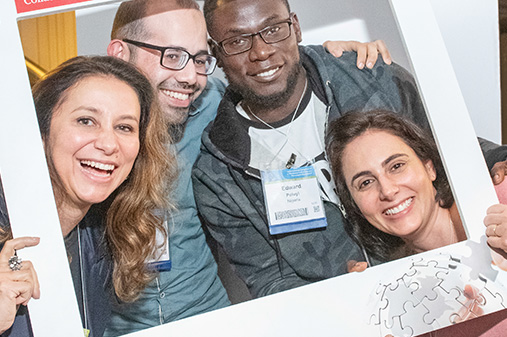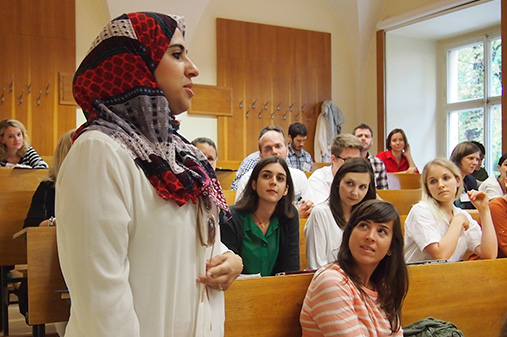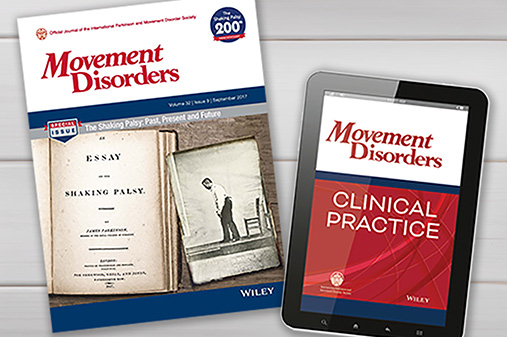Do social workers play a role in preoperative evaluation for DBS?
Nicole Duff: Hello and welcome to the MDS Podcast, the official podcast of the International Parkinson and Movement Disorder Society. I'm Nicole Duff, a physiotherapist at the Wits Donald Gordon Medical Center in Johannesburg, South Africa. And I very pleased to be here with Dr. Amanda Currie from Vanderbilt University in Nashville.
View complete transcript
And today we are going to be discussing her journal article, the Role of a Social Worker in Deep Brain Stimulation Preoperative Evaluation. Dr. Currie, thank you so much for taking the time to join us today, and we are really looking forward to being able to unpack this exciting article.
Dr. Amanda Currie: Thanks so much for the invitation, Nicole. It's an honor. I listen to this podcast frequently, so I'm excited to chat with you today.
Nicole Duff: Oh brilliant. So first can we set the scene a little bit for everyone listening and tell me a bit about what is deep [00:01:00] brain stimulation exactly.
Dr. Amanda Currie: Of course. So Deep Brain Stimulation or DBS as I'll refer to it it involves placement of electrodes into deep brain nuclei to help alleviate various neurological symptoms. The electrodes are connected to an implantable pulse generator. It's usually placed in the chest, like a pacemaker, and then the wires run under the skin and deliver electricity continuously to the brain region of interest. We routinely use it to treat various movement disorders like Parkinson's disease, essential tremor and dystonia. Usually when oral medicines and other conservative therapies like physical therapy, occupational therapy, speech therapy aren't adequately controlling their symptoms.
In the USA where I practice, it's also approved for obsessive convulsive disorder and epilepsy. And I think it's one of the most exciting therapeutic advances that we've seen in the field of movement disorders in the last 30 years or so. And we get to learn more about it every day, and that's some of what I love about [00:02:00] it.
Nicole Duff: As you're talking, I can hear your passion about it. I can see that you're really excited about this field and thank you for sharing that. It's a really comprehensive explanation. So are there any people that can't have DBS?
Dr. Amanda Currie: Yes, patient selection is an important consideration for this therapy. At the end of the day, it is an invasive brain surgery, so people need to be healthy enough from a general medical perspective to undergo the procedure. There's also some specific things that we have to look out for that the surgery can potentially make worse.
So that includes things like gait and balance. So it's important that these domains aren't too impaired for people before they undergo the surgery. Cognition is another important consideration. So procedure can cause declines in certain cognitive domains, so it's important that people undergoing this procedure have some cognitive reserve to fall back upon.
People with the therapy also need to be able to use their patient programmer, charge the [00:03:00] device in some cases. So you can imagine how challenging this could be for somebody with advanced dementia. Next important considerations would be speech and swallow function since those can also get worse after surgery at some centers more than others, age can be a consideration.
Children who are too young with heads that are going to grow can affect the placement of the leads. And then on the other extreme of age when we think about people getting into the 80 and plus range, that's just something to take into consideration and not a hard cutoff. The goal for this screening is really just to ensure that we're maximizing the benefits and the risk benefit ratio. If somebody's found to be on the borderline in these domains, we'll usually just have an honest conversation with them about what symptoms we think we could help. And it's good for things like tremors, stiffness, slowness, abnormal postures, if we're using it for dystonia and then honestly telling them which symptoms we don't think we would help and could even make worse. Then we engage in shared decision making to come to a conclusion [00:04:00] with the patient about whether we want to proceed with the procedure.
Nicole Duff: That is really such a comprehensive overview. Thank you. And so this is what you would be referring to in your article where you spoke about that presurgical evaluation that is done and the number of disciplines that are involved with that.
Dr. Amanda Currie: Exactly. There's a lot of different things that we need to evaluate for especially since this is an elective procedure. So like I said, we just are trying to maximize the benefit in that risk benefit ratio.
Nicole Duff: Brilliant. So what led you to this topic specifically? Why Looking at social workers, why looking at social workers in DBS, what brought you to think about this topic?
Dr. Amanda Currie: Yeah. I did this project during my fellowship. With my two co-fellows, Doctors Burke and Martinez Nunez at the University of Florida. And the idea came from one of our mentoring meetings with one of our mentors, Dr. Okun when we were talking about how we think our social worker improves patient's [00:05:00] experiences and outcomes in the DBS process.
Yet in our discussions with other institutions, we gathered that most other teams don't include social workers routinely and the DBS Presurgical evaluation process. So we just hope to share our experience so that maybe others could learn from it. And the idea really resonated with me because my dad was a social worker and one of my good friends is also a social worker.
So I've got tremendous respect for people in that profession, and I see them as vital members of our team. So I just wanted to share that with the people in our field.
Nicole Duff: I think it's fantastic and I think that often working with different professions and encountering them on a personal level often lets, people can be involved in different situations and often their personal encounter can lead to ideas where research can then help to show in an evidence-based way what you've seen clinically. So I think that your relationships with these individuals has led to some really great research here that you've [00:06:00] been able to publish. So I say thank you to your colleagues. It's wonderful.
Dr. Amanda Currie: Thank you so much. I totally agree.
Nicole Duff: So you mentioned that in other conditions that the role of the social work's been very well defined. Why do you think that the social worker's role has been so overlooked or ill-defined in DBS?
Dr. Amanda Currie: Yeah, you're right. In our literature review we found that other fields like transplant surgery tend to work pretty closely with social workers in the preoperative phase and have a regimented screening. But that's really not the case for DBS. I think part of the reason for that is that social workers have limited time and resources, so it's really hard to find time for them to see everyone who's being evaluated for DBS.
Just to kinda give you an idea about the caseload of some of the social workers at University of Florida last year, we only had one social worker who was covering all of the providers in movement disorders, dementia and behavioral neurology, [00:07:00] neuromuscular disorders, like ALS, and as you can imagine, all of these patients often have a lot of social work related needs, like arranging home care, nursing home placement, caregiver strain, just to name a few. And so there's also kind of financial considerations like how to pay for a social worker's time and compensation structures for how they can bill and things like that.
And finally, I think that the other reason the role for social workers isn't very well defined in the pre-DBS evaluation process is that very few centers are using them in the process right now. So it's really not something most people have even thought about.
Nicole Duff: Thank you. So the specific statement that was made in the article I really loved, which was, most institutions use the social worker in a reactive rather than a proactive manner in the DBS process, missing a critical opportunity to address challenges before they [00:08:00] arise. And I think that in medicine in general, in movement disorders, I think, with medication and with a whole bunch of neuroimaging the whole emphasis at the moment is really being proactive, is really trying to address things before we seeing the fallout from it.
And so I think this statement really is following in the same pathway as everything else that we are moving into with movement disorders. As you say, missing this critical opportunity. Can you expand on this further and explain which challenges do you think can be addressed proactively and how?
Dr. Amanda Currie: Yeah. Thank you. I think this is a really important question. I'll give you a few examples to try and illustrate what we were trying to express with that phrase. So one of the first things that comes to mind is that our transportation barriers. So imagine that there's a person who lives 50 or more miles away from the medical center who might or may not be able to drive [00:09:00] themselves to appointments.
Suppose that they get the DBS surgery, but they can't come back for programming visits to optimize their device settings. The patient might end up being unsatisfied and not getting the best benefit from DBS just because they can't come back to the appointment. And we found in our research that this was a relevant consideration for about 22% of our sample that we found that they weren't driving.
So with the help of our social worker we were able to identify transportation barriers before the patients get surgery, and we can brainstorm solutions to this. Things like designating someone to bring them to appointments as a plan beforehand, or maybe offering vouchers or discounts for public transportation, for ride shares, for hotels.
Another example I'll give you is in identifying a caregiver while the person is recovering from the immediate postoperative period. So for most centers, this involves some general anesthesia, so there's some recovery time. They might have a change in their mobility, a [00:10:00] change in their ability to walk, something like that.
So it's important to have someone around who is identified, who can help them out with their daily activities, help prevent falls, that sort of thing. And in fact in our sample, we found that 16% of the people that we evaluated lived alone. So again, that was a really relevant consideration and what our social worker did was she worked with them to identify a plan A and a plan B for who would be available to support them in that time.
So these are the kinds of things that can potentially be missed by other members of the DBS team. But I think that they're really critical to help optimizing DBS outcomes. In that vein, we developed this screening pneumonic tool that we hope other teams could use to identify these kinds of challenges proactively.
And we can go through that briefly here. So the pneumonic we devised is called FACTS, DBS-FACTS. So the F in that pneumonic stands for finances. So it's [00:11:00] evaluating things like, is the patient expecting to change their insurance soon? Do they have concerns regarding copay you for the visits or for the procedure itself?
The A stands for advanced care planning, so addressing things like do they have an advanced directive in place, which is a really important thing to have, kind o f solidified before someone undergoes an invasive surgical procedure. The C stands for identifying postoperative caregivers. As we had discussed. The T stands for transportation, and again, as we had discussed.
And finally, the S stands for suicidality. So evaluating for things like do they have a history of suicide attempts and do they have any active suicidal ideation? And the importance of that item came from our personal experience in that there can be a decline in mood or even, on the opposite end elevation in mood like a mania type state.
So it's important to identify those things beforehand and be proactive about stabilizing [00:12:00] them and looking for them. And so the idea is that if a patient screens positively on any of these items we would recommend that they have a full consultation with a social worker before they have surgery.
Nicole Duff: Brilliant. I think when you read through and see how you've summarized the social workers role eloquently and as you say, if they mark positive for any of those. They meet with a social worker. But truthfully, when I read your article, I thought everyone that ever sees anyone for DBS needs a social worker that just seems so critical.
Dr. Amanda Currie: Yeah.
Nicole Duff: You also mentioned that the, resources are so low. And so I think being able to take those two aspects the critical need for them, but the low resources, the way that you could combine them and form this this acronym is fantastic. However, do you think that there might be a role for a social worker, almost like in a case management fashion where they oversee the whole running of a patient's c ase from A [00:13:00] to B from the start all the way to the finish?
Dr. Amanda Currie: Sure. Yeah, that's a great point. Like you highlighted, there's many roles that we mentioned in our article that could potentially be filled by a case manager, especially with regard to connecting people to resources, brainstorming plans to optimize postoperative success. Some of the things that we reviewed earlier.
And I'll admit that I'm not completely familiar with the training for each of these two specialists, but my impression is that social workers will often have more experience with conducting bio-psychosocial assessments. So holistic assessment in that assessment piece. And I know social workers also have a little bit of training on counseling and like grief interventional services.
So if say the evaluation uncovered some active suicidal ideation or some maladaptive coping strategies or something like that. A great benefit of a social worker would be that they could potentially implement a short [00:14:00] counseling intervention for that then and there. But I think that, a case manager could also have a really large impact and meaningful impact in the care of these people.
Nicole Duff: So what other clinical implications do you think could possibly arise from this article?
Dr. Amanda Currie: There's a few that I that come to mind. We recently had a very thoughtful letter to the editor that came from Mulder and colleagues in the Netherlands. And they highlighted the importance of the social worker in kind of managing expectations for the procedure and based upon this.
They proposed a very thoughtful and I think appropriate addition to our pneumonic. So they recommended changing it to XFACTS with the X standing for expectation management. And I totally agree with them. I think that's a great addition. So I think that's one clinical implication that really comes from this article and the work that has sparked moving forward.
We also had talked earlier about how the role for social workers in this evaluation really hasn't been very well [00:15:00] defined. So in one of the tables in the article we, clearly listed the roles that we envision for a social worker in this team, or at least that they take at the University of Florida in hopes that other centers could potentially use this as a model for their own DBS programs as well.
Nicole Duff: Absolutely. So you mentioned that because it was a retrospective study, you weren't able to show how the addition of a social worker would've possibly changed the outcome post DBS. Do you think this could be a potential study going forward?
Dr. Amanda Currie: Absolutely. Yeah, I think that there's several different directions that this could go into. I do think that having a control group would be one of the best next steps for this. Just so that we could have a control group to see kind of everyone who sees the social worker in one group compared to no one seeing the social worker or only seeing the social worker as people currently see it retroactively. And then if we're going into groups like that we could even include a third group that [00:16:00] is randomized to use this screening tool and only has a social worker used on an as needed or when they screen positively on our sample. And then I think another important part.
Would be prospectively collecting outcomes like patient satisfaction, caregiver satisfaction, clinical outcomes. And that would be a really nice prospective way to evaluate all of these different roles and things we're talking about.
Nicole Duff: It all sounds so exciting. Highlighting again, different professionals roles within this very exciting surgery that's being done to assist our patients. With regards to this pneumonic that you guys have created, and now with the Netherlands joining in, do you have any ideas on how you could perhaps roll it out into different clinics or to start using clinical practice on a wider scale?
Dr. Amanda Currie: Yes, I think that, it's fine and well to write about things in the literature, but if people can't, bring it to the bedside, then what is it worth? Not very much. So [00:17:00] we tried to think about that and propose different ways that people can integrate it into their clinical workflow. One is in the supplement, we included a patient facing tool that could be administered to a patient and they could take it as a survey type format, either electronically if the patient is, familiar with that and that electronic health record has that capability.
Or it could be mailed to them as a hard copy and ask them to bring it to their appointment. And to have that screening in hand for the clinician when they see them. And then the figure that we included in the article is more of a clinician based tool that they could potentially use as a guide in their clinical encounter to go through those things very briefly and see if they needed to schedule a visit.
And the last way I had envisioned that potentially this could work would be in centers with a DBS coordinator. So someone who takes care of kind of scheduling the appointments for the evaluation and that sort of [00:18:00] thing. Potentially when they're on the phone scheduling those appointments in the first place they could run through those questions, just see if they have social work needs, and then that would be really easy to schedule the social work visit right then and there.
And have that taken care of. So lots of different options to integrate it clinically, hopefully.
Nicole Duff: I think it's great and you've clearly thought about it in a lot of details to see, again, how you can translate the research into clinical practice, which is awesome.
That's everything from my side. I don't know if there's anything more you'd like to share with our listeners from your side.
Dr. Amanda Currie: I think that we covered all the high points. I appreciate your thoughtful questions and guiding us through the article in a way that hopefully is important to these patients with these conditions and the people who take care of them.
Nicole Duff: Thank you so much again for joining us. It's really been wonderful having you and thank you for the opportunity to chat with you and like I say, unpack this topic. [00:19:00] I think it's so exciting and I really appreciate your time and I look forward to seeing where this topic takes us in the future.
So thank you so much.
Dr. Amanda Currie: Thank you so invitation. It's a real honor to be able to speak on the podcast.

Amanda Currie, MD
Vanderbilt University Nashville, TN, USA









